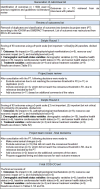Core outcome set for cardio-oncology: development of a set of outcomes for the cardiovascular assessment and monitoring of cancer patients and survivors
- PMID: 38796695
- PMCID: PMC12187047
- DOI: 10.1093/ehjqcco/qcae038
Core outcome set for cardio-oncology: development of a set of outcomes for the cardiovascular assessment and monitoring of cancer patients and survivors
Abstract
Aims: There is an increasing awareness of the evidence-based selection of outcomes to be measured in clinical trials and clinical practice. Currently, there is no core outcome set (COS) for cardio-oncology, which may hinder the (inter)national comparison of the effectiveness of research and the quality of cardio-oncology care. The aim of this study is to develop a standard and pragmatic patient-centred outcome set to assess and monitor cancer patients and survivors at risk of or with cardiovascular diseases.
Methods and results: A list of outcome domains was generated through a review of registries and guidelines, and six patient interviews. The project team reviewed and refined the outcome domains prior to starting a two-round Delphi procedure conducted between January and June 2022. The panellists, including healthcare providers and researchers, were invited to rate the importance of the outcomes. Twenty-six experts from 11 countries rated a list of 93 outcomes (round 1) and 63 outcomes (round 2) to gain consensus on a list of outcome measures, and of demographic factors, health status, and treatment variables. The final COS includes 15 outcome measures, reflecting four core areas: life impact (n = 2), pathophysiological manifestations (n = 9), resource use/economic impact (n = 1), and mortality/survival (n = 3). Next, 6 demographic factors, 21 health status, 3 cardiovascular, and 9 cancer variables were included.
Conclusions: This is the first international development of a COS for cardio-oncology. This set aims to facilitate (inter)national comparison in cardio-oncology care, using standardized parameters and meaningful patient-centred outcomes for research and quality of care assessments.
Keywords: Cardio-oncology; Core outcome set; Outcome measure; Patient registry; Patient-reported outcomes.
© The Author(s) 2024. Published by Oxford University Press on behalf of the European Society of Cardiology.
Conflict of interest statement
Conflict of interest: none declared.
Figures
References
-
- Sase K, Kida K, Furukawa Y. Cardio-oncology rehabilitation-challenges and opportunities to improve cardiovascular outcomes in cancer patients and survivors. J Cardiol 2020;76:559–567. - PubMed
-
- Curigliano G, Cardinale D, Dent S, Criscitiello C, Aseyev O, Lenihan D et al. Cardiotoxicity of anticancer treatments: epidemiology, detection, and management. CA Cancer J Clin 2016;66:309–325. - PubMed
-
- López-Sendón J, Álvarez-Ortega C, Zamora Auñon P, Buño Soto A, Lyon AR, Farmakis D et al. Classification, prevalence, and outcomes of anticancer therapy-induced cardiotoxicity: the CARDIOTOX registry. Eur Heart J 2020;41:1720–1729. - PubMed
MeSH terms
Grants and funding
LinkOut - more resources
Full Text Sources
Medical




